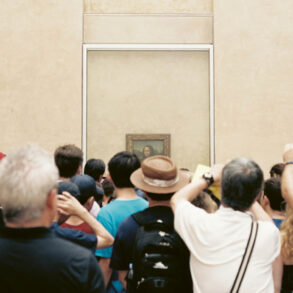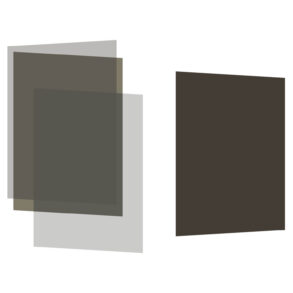At his art events, the German performance artist and art theorist Joseph Beuys (1921-1986) advocated the need for a connection between Europe and Asia. The symbol of this encounter for him was the hare. A search for traces in his work.
When Joseph Beuys decided to perform with a hare, it was originally a stopgap solution. The reason being, as art collector Hans van der Grinten (1929-2002) reported, he had planned to perform with a deer at his events. The deer, however, proved to be too unwieldy, and intuitively, the hare was the right choice after all! At one of his first events ‹Wie man dem toten Hasen die Bilder erklärt› [How to Explain Pictures to a Dead Hare] in November 1965, at the Galerie Schmela in Düsseldorf, Beuys locked the door from the inside and left the visitors outside. With his head completely covered with gold leaf, gold dust, and honey, the animal in his arms, and apparently, in dialogue, he walked from object to object through the exhibition. Only after three hours was the audience allowed into the space – there was Beuys, sitting on a stool in the entrance area with his back to the audience, the hare in his arms.
The Origin of the Hare
In Roland Albrecht’s ‹Museum der Unerhörten Dinge› [Museum of Outrageous Things], one can read: «During his flight in 1944 with the JU 87, he [Beuys] was hit by a Russian anti-aircraft gun but was able to escape behind the front line. Nevertheless, he crashed due to a terrible snowstorm. In ‹a complete wasteland at the top of the edge of the bottleneck of Crimea›, Tatars living there found the severely wounded and unconscious pilot. The Khairetdinov family cared for the mostly comatose man. They rubbed his wounded, injured body with animal fats, wrapped the battered body in felt blankets, and placed burning candles around where he lay. The candles were called hare candles and were shaped like hares. These candles are widely used in the settlement area of the Tatars – from ancient times, hares have been regarded by the Tatars as bringers of light, as light keepers, and since earliest times they have been making candles in the shape of hares. Even today, one can find these hare candles in every southern Russian grocery store. These hare candles, these light-giving hares, were the first and for a long time the only thing Joseph Beuys saw and perceived when he awoke from his deep unconsciousness.»1 Whether this story corresponds to actual truth or is a narrative initiated by Beuys after the crash is of no interest here. In any case, the location of the story (Crimea/Ukraine) and the connection with Beuys’s favorite animal, the hare, is fascinating.
The Eurasian Utopia
The Tatar narrative refers to Beuys’s Eurasian vision, a foundation of his political thinking. While in 1968, students were demanding a revolution based on Marxist ideology – an improvement of existence through economic change – the artist was developing his Eurasia performance series. In it, he not only addressed the violent confrontation of the blocs – in contrast to the leftists influenced by Anglo-Saxon ‹hippies› – but directed his sight to the spiritual East. In May 1967, Beuys proclaimed the ‹free democratic socialist state of Eurasia› – a vision that meant the opposite of today’s imperialist concept of Eurasia. In June, the first performance of ‹Eurasienstab› [Eurasian Staff] followed in Vienna: With organ music and liturgical movements, the performer tried to transfer energy in all four directions with a copper rod as well as fat and light – the rite of spiritual distributive justice in the sense of Rudolf Steiner’s idea of the threefold structure of the social organism.
Beuys opened the planting-event of the ‹7000 Eichen› [7,000 Oaks] with the performance ‹Friedenshase mit Zubehör› [Peace Hare with Accessories]. German artist and author Johannes Stüttgen describes the event: On June 30, 1982, the promised melting of the replica of Ivan the Terrible’s crown took place, as announced by Joseph Beuys at the press conference for the opening of documenta 7 (documenta 7 was the seventh edition of documenta, a quinquennial contemporary art exhibition in Kassel, West Germany). The artist had received the crown from Düsseldorf restaurateur Helmut Mattner, who had it made according to the original by jeweller René Kern in the early 60s, in order to display it in a glass case in the ‹Datscha› pub in Düsseldorf’s old town, and sometimes pass it around filled with Crimean sparkling wine to guests who were particularly willing to pay. An ancient symbol of autocratic rule, run down by the kitsch of affluent capitalist society, had had its day – a demonstration object for Joseph Beuys as if made for the demonstration of his idea of ‹sculpture› which envisaged the remelting of all used-up concepts and forms, not least of the ruling social system. It was to be transferred into the world in real terms with the sculpture ‹7,000 Eichen›, which had just been started. […] This action of transformation, which took place publicly – on the podium, but hidden for most – in the midst of the crowd of journalists, against organized protests of the jewellery trade and angry sections of the population, had a mysterious, dramatic quality reminiscent of a heretic tribunal or an alchemical demonstration. Beuys pulled the flashing Tsar’s crown out of a plastic bag, showed it to the crowd with his hand outstretched, and spoke into the microphone: «Here we go! So now the crown of Ivan the Terrible will be melted down. I’ll show it to you once last time.» Then, smiling, he withdrew into the inner circle, where the fire had already been kindled in the makeshift brick oven. He unscrewed the cross from the tip of the crown and, after carefully dismantling all the precious stones from the crown and placing them with the cross into a preserving jar, he broke apart the frame of the crown and threw each individual piece of gold sheet into a vessel immersed in the embers. The preserving jar was marked with the inscription: «It all depends on warmth characteristics in thinking. This is the new quality of will.» It took time for the embers to be heated to 1,100 degrees. Beuys called out the names of the great alchemists at rhythmic intervals: Agrippa von Nettesheim, Athanasius Kircher, Theophrastus Bombastus, Aureolus von Hohenheim, and Paracelsus. When the gold began to boil, he jumped up and shouted across Friedrichplatz, himself having become a magician in a state of rapture: «Now the gold has sunk! The gold – the gold – it’s looking! The gold – it’s looking, it’s looking!» The solid form of the metal had been transformed by the heat into chaotic energy. And now the crackling tincture could be poured into a new shape, which the artist had prepared, until then known only to himself: into the form of a hare.

The Symbol of the Hare
Beuys had demonstrated the basic principles of his ‹Theorie der Plastik› [Theory of Sculpture], related to the three aspects of chaos – movement – form, which had already appeared in Paracelsus as sulfur – mercury – salt, this time in gold. The result was the hare. Throughout his events, he repeatedly used this animal as a sign of the love connection between heaven and earth, mobility and peace, and the connection between East and West (Eurasia). From the remaining gold he poured a small sun sphere and exclaimed «Now we have a hare and the sun!» – Beuys called it the peace hare. The artwork is now in the Staatsgalerie in Stuttgart, and the proceeds flowed, as planned from the beginning, entirely into the ‹7000 Eichen› [7,000 Oaks].2
We developed our signet from this event, within the framework of the FIU (Free International University). It was also initially the logo of the movement for three-tier popular legislation that began in Achberg in the early 1980s.
Ukraine and Central Europe
The fact that the crown was a replica of Ivan the Terrible’s crown may be irritating, and one wonders today who Ivan the Terrible is. Did Beuys have some kind of intuition? In any case, according to the latest ‹measurements›, the southwestern part of Ukraine lies in Central Europe. «Dilove (in the triangle Romania/Hungary/Slovakia) is a village in southwestern Ukraine on the Romanian border. In 1977, a stele was erected there with an inscription stating that the geographical center of Europe is located here.»3
What more is needed today than a vision that connects Europe with Asia, and not just on an economic level but especially on an idealistic and cultural one? Do we need to pressure Putin into the Russian Empire? The hare runs left and right when one of his brothers (Ukraine?) gets into trouble. The ‹Eurasian Hare› would be the one that races back and forth «from Vladivostok to Ostend», 11,750 kilometers, connecting the two ends instead of supplying weapons. Or should he do the same, since the hare also defends itself when it comes to its young? Do we have to invite Putin to Achberg? Or would it be better to think about how we can support Russian civil society?4 I quote Beuys from a lecture he gave on the Swiss shore of Lake Constance in 1985: «So, don’t always be afraid of the Russians. […] Is it always so important that we have people here at Lake Constance? Russians could also live here. And the people on Lake Constance could also live in Moscow. Would it even be a possibility, if they all walked in here, the Russians, to get into a conversation with them?»
For Beuys, the hare was «the sign of movement, especially in the Eurasian steppe, between East and West and West and East. Therefore, we will make this peaceful little animal, which every child knows, a symbol of peace. However, we are obliged to solve the problem of East and West and West and East. And that’s what we’ve set out to do.» (Beuys in the ‹WDR› interview on March 16, 1982).
Always on the Move
Each age has its own laws. For this reason, I don’t want to judge why Beuys volunteered for the Luftwaffe in the spring of 1941, enlisting for twelve years. On March 4, 1944, he was shot down by a Russian anti-aircraft gun and made an emergency landing in a snowstorm on the Crimean Peninsula, killing his fellow pilot. He concludes that we need a permanent connection and movement between the West and East, and he assigns this movement to the Eurasian Hare, whereby Central Europe, which includes parts of Ukraine, has a central position. The Eurasian Hare defends its right to exist – even with its own weapons. At the same time, it prevents the expansion of the Great Russian Empire toward the center. However, it is constantly on the move to unite the seemingly irreconcilable opposites, trying at least to bring them into a conversation. The West doesn’t have the right to force large parts of Ukraine and Belarus under its influence, nor does Eastern Europe have the right to extend its state power into Central Europe.
A Europe of the Regions?
The nation state seems to have had its day. The direct democratic path has always been one that came closest to democracy and freedom. Why shouldn’t Ukrainian regions decide in internationally observed votes to which hemisphere they want to belong – always under the motto of ‹subsidiarity›, that is, a regulatory (or formative) competence? Legislation and other competencies should take place at the lowest possible level. And there should be freedom in intellectual life. The European Community would only step in when member states cannot adequately handle certain tasks or if objectives and tasks could be better achieved at the EU level. Weapons have no place there, not on either side, whereas the Ukrainian regions have the right of self-determination to decide which hemisphere they want to belong to!
However, given that weapons were brought in by the Russian side a year ago, Ukraine also has the right to defend itself with weapons, so that the contested areas can be transferred to self-government. In an artistic image, one can reveal a vision. Realpolitik, however, has the task of finding concrete solutions.
The signet ‘Hare and Sun’ is available as a sticker, badge and patch from FIU Publishing.
Translation Monika Werner
Footnotes
- Museum der Unerhörten Dinge
- Stiftung 7000 Eichen
- Dilowe
- «Aktive Neutralität – Die Überwindung von Kapitalismus und Kommunismus» [Active Neutrality – Overcoming Capitalism and Communism], Lecture Rorschach/Switzerland, January 1985, recorded and published by/in FIU-Verlag as a booklet, CD, and DVD.










the continuous illusion that Russian people are the ‘native’ owners of the entire northern Eurasian land mass from Vladivostok to St Peterburg, is a nonsense beyond all empirical/archeological/anthropological evidence. These northern land masses were for millennia impenetrable for their environmental/survival remoteness. Eurasia was never a unified landmass nor a single geographic entity and only assumed that position because of US fears and stupidity in negotiating with Stalin at Potsdam based on total mistaken assumptions and a desperate desire to get out of European affairs after 2 world wars that cost the US citizens far far more than they were ever going to gain. Which is why on both occasions the US population was extremely divided on being dragged into foreign conflicts. The Russian’s of today pretend that they were the real victors of WW2? well maybe ask the Poles or All other Iron curtain countries about that perspective but in any case the entire existence of what we called the soviet union was simply an accident of unforeseen proportions by the allied forces. With the fall of the USSR when the US had the upper hand and the ‘Cold War’ was won, nothing was concluded to rectify the errors of Potsdam. The same malaise of permissive attitudes prevailed and the result was that some little idiot from a small Stasi office in Dresden eventually came to replace the progressive Gorbachev and now we have the worlds most powerful and corrupt mafia running the entire planetary crime (weapons slavery body parts drug cartels etc) that the world has ever known. Their penetration into modern commercial free enterprise is so systemic/endemic that it’s beyond belief except to those that understand the power of Ahriman who is now supported by the distorted lucidity of Luciferic scientific knowledge made manifest via the technological mass media WWW networks .. suddenly all the attention has revolved towards Ukraine but the ‘war’ of corruption, which has always prevailed in open economic market places, is now endemic within every aspect of socio political economic life in all countries from Israel to Zimbabwe. The northern Europeans Tribes (Prussians etc) had existed for centuries under Tsarists regimes who sought to emulate the French-ballet or Germanic-music, to escape the tyranny Tsarists regimes who continually sought to emulate their European cousins. Modern genetic research clearly indicates that the only ‘real’ Russian peasants/people are in fact Ukrainians but their northern masters (Prussian aristocracy) who pretend that they were God specially chosen similar to the many other tribes (Slavs Aschkenase Armenian etc) all sought to make a home under the Czars. The remnants of all those tribes are what we today we call the EU of which most also decided to join NATO which in fact was simply a left over of small tribal FEAR of bigger tribes attacking them as had happened over the past millennia. So now those same tribes want autonomy and independence from their former imperial masters and the US has been stupid enough to provide a supposed nuclear umbrella over these NATO nations. And now we have the chief dictator who views himself as Peter the great trying to rebuild the prestige he grew up under in his USSR fantasy. This is not going to happen regardless energy sources or the other tribal machinations of Hungary Serbia Check Turkey Israel etc etc they all want the freedom that the US once had but has long since disappeared into the power hungry elitist state that Eisenhower warned them of at his departure. o now it’s upon again the same despots across Europe all claiming assorted grievances and relying on the US to save them from their own stupidity greed and corruption.
It’s no longer a question of who’s right because Rubicon has passed it’s now about which side of history humanity should prevail? follow the Putin/Zxi/Ergogan/Bashir/Orban etc trail or the old tired worn out former migrants? which one do you trust more?